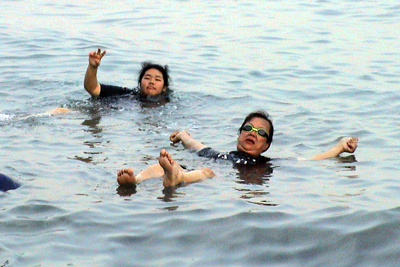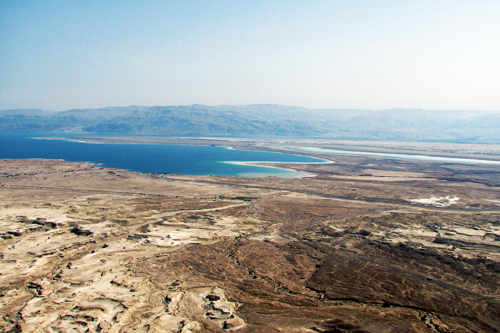
Probably the most prominent geographical feature of Palestine, the Dead Sea has also been called the Salt Sea (yam hammelach, e.g., Gen 14:3), the Sea of the Arabah (yam ha'arabah, e.g., Jos 12:3), and the Eastern Sea (yam haqqadmoni, e.g., Joel 2:18).
Open Map ☰

The water is so concentrated, salts naturally crystalize from it.
The sea-bed, at 860m below sea level, sets the record for being the deepest depression on the face of the earth. Its width and length, however, have varied over time; 80km by 15km is a good approximation. The most severe shrinking of the sea has happened in modern times. As the pressure grew to tap increasing amounts of water from the Sea of Galilee by modern Israel and Jordan, so less and less water feeds into the Dead Sea to help maintain its level. Hotels built in the 1980's on the shore of the sea are now left hundred of metres inland, and it is not uncommon to see markers indicating the level of the shore lines in th 1950 stranded like lonely sentinels several stories high on the side of the road that used to hug the sea.
The Dead Sea is surrounded by the steep cliffs of Moab (modern Jordan) on the east, and the gentler cliffs of the Judean wilderness on the west. From these a few streams feed into the sea. The high temperature of the region results in an evaporation of about 2.5 cm of water from the sea everyday during the summer. This also results in the high concentration of salts in the water; 27%wv of the water is composed of sodium and calcium chlorides, potash, and bromides, which are mined. This provides the sea with its famous bouyancy but also the impossibility of aquatic life. The Nabateans also used to harvest and to trade in the bitumen that floated to the surface.

Tourists enjoying the natural bouyancy of the sea.
The Dead Sea may be divided into two regions by the Lisan Peninsular, a tongue of land extending from the eastern shore to within three kilometers of the opposite shore. The channel in between was always rather shallow; in ancient times a path forded the sea at this point, and it was guarded by from the Hasmonean era by the fort of Masada. The channel is now all but dried up. The lower end of the sea is relatively shallow, reaching to an average depth of 30m, while the northern portion of the sea reaches down more than 430m.

View of the Lisan from Masada. The channel that used to separate the two sides have now dried up.

FURTHER READINGS:
Tina Niemi, Zvi Ben-Avraham and Joel Gat, eds., The Dead Sea: The Lake and Its Setting. Oxford: Oxford University Press, 1997.
Tina M. Niemi, "The Life of the Dead Sea," Biblical Archaeological Review 34.1 (Jan/Feb 2008): 34-49 & 84.

©ALBERITH
191016lch/u